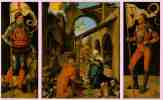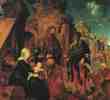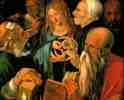![]()
Timeline: Northern Renaissance
I hold that the perfection of form and beauty is contained in the sum
of all men.
-- Dürer, Four Books on Human Proportions, 1528
Dürer, Albrecht (b. May 21, 1471, Imperial Free City of Nürnberg [Germany]--d. April 6, 1528, Nürnberg), German painter, printmaker, draughtsman and art theorist, generally regarded as the greatest German Renaissance artist. His vast body of work includes altarpieces and religious works, numerous portraits and self-portraits, and copper engravings. His woodcuts, such as the Apocalypse series (1498), retain a more Gothic flavour than the rest of his work.
Born in Nürnberg as the third son of the Hungarian goldsmith Albrecht Dürer. Began as an apprentice to his father in 1485, but his earliest known work, one of his many self portraits, was made in 1484. Died in Nürnberg in 1528.
During 1513 and 1514 Dürer created the greatest of his copperplate engravings: the Knight, St. Jerome in His Study, and Melencolia I--all of approximately the same size, about 24.5 by 19.1 cm (9.5 by 7.5 inches). The extensive, complex, and often contradictory literature concerning these three engravings deals largely with their enigmatic, allusive, iconographic details. Although repeatedly contested, it probably must be accepted that the engravings were intended to be interpreted together. There is general agreement, however, that Dürer, in these three master engravings, wished to raise his artistic intensity to the highest level, which he succeeded in doing. Finished form and richness of conception and mood merge into a whole of classical perfection.
 The Seven Sorrows of the Virgin
The Seven Sorrows of the Virgin
c. 1496-97 (200 kB); Oil on panel, Central panel 109 x 43 cm;
Alte Pinakothek, Munich;
Side panels 63 x 46 cm;
Gemaldegalerie Alte Meister, Dresden
 St. Michael's fight against the dragon
St. Michael's fight against the dragon
1498 (330 kB); Woodcut, 39.2 x 28.3 cm (15 x 11 1/8 in)
 The Paumgartner Altarpiece
The Paumgartner Altarpiece
c. 1498-1504 (150 kB); Oil on panel, Central panel 155 x 126 cm;
Side panels 157 x 61 cm;
Alte Pinakothek, Munich
 A Young Hare
A Young Hare
1502 (140 kB); Watercolor and gouache on paper, 25 x 23 cm;
Graphische Sammlung Albertina, Vienna
 The Large Turf
The Large Turf
1503 (180 kB); Watercolor and gouache on paper, 41 x 32 cm;
Graphische Sammlung Albertina, Vienna
 The Adoration of the Magi
The Adoration of the Magi
1504 (60 kB); Oil on wood; Uffizi
 Christ Among the Doctors
Christ Among the Doctors
1506 (150 kB); Oil on panel, 65 x 80 cm;
Fundacion Coleccion Thyssen-Bornemisza, Madrid
 St Anne with the Virgin and Child
St Anne with the Virgin and Child
1519 (160 kB); Oil and tempera on canvas, transferred from panel, 60 x 50 cm;
Metropolitan Museum of Art, New York
Dürer was so great an artist, so searching and all-encompassing a thinker, that he was almost a Renaissance in his own right -- and his work was admired by contemporaries in the North and South alike. The 16th century saw the emergence of a new type of patron, not the grand aristocrat but the bourgeois, eager to purchase pictures in the newly developed medium of woodcut printing. The new century also brought an interest in Humanism and science, and a market for books, many of which were illustrated with woodcuts. The accuracy and inner perception of Dürer's art represent one aspect of German portraiture; another is seen in the work of that master of the court portrait, Holbein.
Impressive though others may be, the great German artist of the Northern Renaissance is Albrecht Dürer (1471-1528). We know his life better than the lives of other artists of his time: we have, for instance, his letters and those of his friends. Dürer traveled, and found, he says, more appreciation abroad than at home. The Italian influence on his art was of a particularly Venetian strain, through the great Bellini, who, by the time Dürer met him, was an old man. Dürer was exceptionally learned, and the only Northern artist who fully absorbed the sophisticated Italian dialogue between scientific theory and art, producing his own treatise on proportion in 1528. But although we know so much about his doings, it is not easy to fathom his thinking.
Dürer seems to have united a large measure of self-esteem with a deep sense of human unfulfillment. There is an undercurrent of exigency in all he does, as if work was a surrogate for happiness. He had an arranged marriage, and friends considered his wife, Agnes, to be mean and bad-tempered, though what their real marital relations were, nobody can tell. For all his apparent openness, Dürer is a reserved man, and perhaps it is this rather sad reserve that makes his work so moving.
 Self-Portrait at 26
Self-Portrait at 26
1498 (140 kB); Oil on panel, 52 x 41 cm;
Museo Nacional del Prado, Madrid
The Germans still tended to consider the artist as a craftsman, as had been the conventional view during the Middle Ages. This was bitterly unacceptable to Dürer, whose second Self-Portrait (out of three) shows him as slender and aristocratic, a haughty and foppish youth, ringletted and impassive. His stylish and expensive costume indicates, like the dramatic mountain view through the window (implying wider horizons), that he considers himself no mere limited provincial. What Dürer insists on above all else is his dignity, and this was a quality that he allowed to others too.
Even a small and early Dürer has this momentousness about it. His Madonna and Child, which manifestly follows the Venetian precedent of the close-up, half-figure portrait, was once thought to be by Bellini. To Dürer, Bellini was an example of a painter who could make the ideal become actual. But Dürer can never quite believe in the ideal, passionately though he longs for it. His Madonna has a portly, Nordic handsomeness, and the Child a snub nose and massive jowls. All the same, He holds His apple in exactly the same position as in Dürer's great engraving of Adam and Eve, and this attitude is pregnant with significance. The Child seems to sigh, hiding behind His back the stolen fruit that brought humanity to disaster and that He is born to redeem. On one side is the richly marbled wall of the family home; on the other, the wooded and castellated world. The sad little Christ faces a choice, ease or the laborious ascent, and His remote Mother seems to give Him little help. Beautiful though the work is in color, and fascinating in form, it is this personal emotion that always makes Dürer an artist who touches our heart, somehow putting out feelers of moral sensibility.
 Adam and Eve
Adam and Eve
1504 (250 kB); Engraving, 24.8 x 19.2 cm (9 3/4 x 7 1/2 in)
 Adam and Eve
Adam and Eve
1507 (110 kB); Oil on panel, Each panel 209 x 82 cm;
Museo Nacional del Prado, Madrid
There is almost obsessive quality about a great Dürer. One feels the weight of a sensibility searching into the inner truth of his subject. It is this inwardness that interests Dürer, an inner awareness that is always well contained within the outer form (he is a great portrait painter) but that lights it from within.
 The Four Holy Men
The Four Holy Men
1526 (120 kB); Oil on panel, Each panel 215 x 76 cm;
Alte Pinakothe, Munich
Having rejected the Gothic art and philosophy of Germany's past, Dürer is the first great Protestant painter, calling Martin Luther ``that Christian man who has helped me out of great anxieties''. These were secret anxieties, that hidden tremulousness that keeps his pride from ever becoming complacent. Although there is no reason why any Catholic artist should not have painted The Four Apostles, nor why such an artist should not equally have chosen first John and Peter (indisputably biblical Apostles), then Paul and Mark (mere disciples, not ordained by Christ in the Gospel story, though they were great preachers of the Word), it strikes a definitely Protestant note.
These four embody the four temperaments: Dürer had a consistent interest in medicine and its psychological concomitants, since in some way he found humankind mysterious, and it was a mystery he pondered constantly.
 Portrait of Durer's Father at 70
Portrait of Durer's Father at 70
1497 (130 kB); Oil on panel, 51 x 40 cm;
National Gallery, London
Dürer came from a Hungarian family of goldsmiths, his father having settled in Nuremberg in 1455. In The Painter's Father Dürer shows the face with respectful sensitivity. The technique is pencil-like, precise, and enquiring; the description achieved has a hard brilliance. However, the rest of the picture may be incomplete, or not all Dürer's work. The rudimentary background is a far cry from the detailed one in Dürer's own Self-portrait, and the sitter's clothing is hardly more than sketched in.